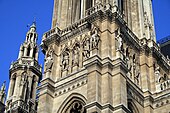Vienna City Hall
This article has multiple issues.Please helpimprove itor discuss these issues on thetalk page.(Learn how and when to remove these template messages)
|
| Vienna City Hall | |
|---|---|
Wiener Rathaus | |
 Vienna City Hall at the Rathausplatz | |
 | |
| General information | |
| Type | Town hall |
| Architectural style | Gothic Revival |
| Location | Vienna, Austria |
Vienna City Hall(German:Wiener Rathaus) is theseat of local governmentofVienna,located on theRathausplatzin theInnere Stadtdistrict. Constructed from 1872 to 1883 in aneo-Gothicstyle according to plans designed byFriedrich von Schmidt,it houses the office of theMayor of Vienna,as well as the chambers of the city council and ViennaLandtagdiet.
History[edit]

By the mid 19th century, the offices in theold Vienna town hall,dedicated by theAustriandukeFrederick the Fairin 1316 and rebuilt by theBaroquearchitectJohann Bernhard Fischer von Erlacharound 1700, had become too small. When the lavishRingstraßewas laid out in the 1860s, a competition to build a new city hall was initiated, won by theGermanarchitect Friedrich Schmidt.
MayorCajetan Felderurged for the location on the boulevard where simultaneously numerous representative buildings were erected, such as theVienna State Opera,theAustrian Parliament Building,the main building of theVienna University,or theBurgtheater.Construction costs amounted to a total of about 14 millionflorins,borne by both the City of Vienna and theImperial-Royal(k.k.) government after lengthy debate.
Big Build[edit]

The design of the richly adorned facade is modelled on theGothic architectureofFlemishandBrabantsecular buildings likeBrussels' Town Hall.It features five towers including the central tower with a height of 98 m (322 ft). On 21 October 1882, theRathausmannstatue was installed on the top, which soon became one of the symbols of Vienna. The structure itself, spread over an area of 19,592 m2(210,890 sq ft), is arranged around seven inner-courtyards, more along Baroque lines. A total space of about 113,000 m2(1,220,000 sq ft) is spread over three floors and two basements with 2,987 rooms. It is largely built with bricks decorated withlimestone,mainly from theLeitha Mountains,andashlarmasonry.
The City Hall also accommodates the historic 'Wiener Rathauskeller' restaurant. The traditional restaurant consists of several baroque halls, offering small traditional Viennese delicacies to grand gala buffets.
Facing the city hall is the largeRathauspark.
Structure[edit]
The Vienna City Hall has the following structure from top to bottom:
- Main Tower (Rathausmann)
- Attic Storey
- 2nd Floor
- 1st Floor
- Half-Floor
- Ground Floor
- 1st Basement
- 2nd Basement
Main Tower[edit]
Atop the steeple of the 98-meter high tower, stands the 3.4-meter tallRathausmann;an iron standard bearer. It was designed by Alexander Nehr, and donated by master locksmith and factory owner Ludwig Wilhelm.
The statue was attached to the spire on 21 October 1932.[1]
First floor[edit]
The ballroom can be found on the first floor at the front of the hall, with views of the ring road,Burgtheater,and inner city. The first floor ballroom is 71 m (233 ft) long and spans a width of 20 m (66 ft).[2]The ballroom runs adjacent to the banqueting hall, also adjoining with the north buffet and armorial hall.
The Municipal Council Meeting Room and Municipal Senate Meeting Room are both also part of the first floor.
Ground floor[edit]
There are numerous entry points into the Vienna City Hall via the ground floor. There are entrances to the north, south, and west.
The Volkshalle, or "People's Hall", is located on the ground floor, right below the first floor ballroom. The Volkshalle is used nowadays to host events.[3]
Additionally, since 1927, the town hall guard, a special unit of the Viennese professional fire brigade, has resided in the ground floor of the town hall for security. Their duties include standard fire response duties and disaster control.
First basement[edit]
The first basement, also called theVienna City Hall cellar,was first opened on 12 February 1899. The artistic design was overseen by Josef Urban, and the historical murals by Heinrich Lefler. The first basement contains numerous rooms including the Knights' Hall, the Green Hall, and the Grinzinger Keller.
There were extensive renovations performed in 1925,[4]1952,[5]and 2005, where historical murals and woodwork were fully refurbished.
Renovation work[edit]
On September 27, 2012, renovation work[6]started on what is expected to be a 35 million euro project to renovate the building by the year 2023 when the work – expected to take place in 11 stages and affecting 40,000 m2– will be complete. Recently finished renovations (2000) include the grand re-opening of theneo-BaroqueSalon Ziehrer and the redesigned Lanner-Lehar Hall with wall and ceiling murals by GermanTrompe-l'œilartistRainer Maria Latzke.[7]
Gallery[edit]
-
City hall at night
-
Detail of the facade at the base of the main tower
-
Rathausmannat the top
References[edit]
- ^"The New Town Hall".Neue Freie Presse.Retrieved21 September2020.
- ^"Festsaal - Rathausführung".Wien.gv.at.Retrieved21 September2018.
- ^"Das Stadtservice Wien".Wien.gv.at.Retrieved24 August2019.
- ^"The Vienna Rathauskeller".Wiener Bilder.Retrieved21 September2018.
- ^"Wien 1952: Berichte vom Mai 1952".Wien.gv.at.Retrieved21 September2018.
- ^"Rathaus to get a new look - General News - Austrian Times Online News - English Newspaper".Archived fromthe originalon 2014-11-09.Retrieved2012-09-27.
- ^"Lanner Lehar Hall".Rainermarialatzke.com.



